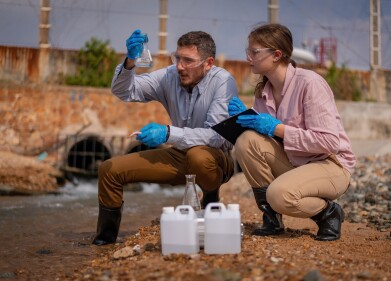Water/wastewater
What Are Organic Micropollutants?
Jun 25 2022
As the name suggests, the term micropollutants refer to a wide-ranging group of chemicals, metals and other substances which are emitted into our environment in very small concentrations. Many of these micropollutants are organic, meaning they occur naturally. As such, it might seem at first glance as though they do not pose cause for concern to human, animal or plant health.
However, increased anthropogenic activity over the last few centuries means that such a supposition is not correct. Although the substances themselves may be organic, the processes and products via which they are returned to the air, soil and water are not natural. What’s more, many of these micropollutants have the ability to persist in our environment for a very long time, allowing them to bioaccumulate and reach levels that are harmful to the planet, the organisms living upon it and even humans.
Where do organic micropollutants come from?
The fact that they occur organically in nature might suggest that micropollutants are harmless, but their use in a wide variety of household and industrial processes means that they are being emitted back into the environment in greater quantities than ever before.
Some common examples of organic micropollutants include cosmetics, personal care products (PPCPs), pharmaceuticals, pesticides, herbicides, fertilisers, per- and polyfluoroalkyl substances (PFAS), artificial sweeteners, phthalates, oestrogens, hormones and chemicals used in industry. Some of these substances are used by all of us in our everyday lives, while some are emitted into the environment in greater quantities as a result of large-scale industrial processes.
To dig a little deeper, some of the specific substances in question which belong to these various subcategories include polycyclic aromatic carbons (PAHs), polychlorinated biphenyls (PCBs), polybrominated diphenyl ethers (PBDEs), dichloro-diphenyl-trichloroethane (DDT), bisphenol A, alkylphenols, methiocarb, oxadiazon, thiacloprid, acetamiprid, diclofenac, among many, many others.
What is being done about organic micropollutants?
Many of the aforementioned substances are classified as emerging micropollutants (EMPs), meaning little is known about them. Although water analysis has progressed significantly in recent years, there is still a dearth of scientific research into the long-term effects of elevated levels of these organic micropollutants on natural ecosystems and on human health.
Nonetheless, we do know that many of the aforementioned chemicals and substances are detrimental to the functioning of marine and freshwater flora and fauna. Since these micropollutants invariably end up in our rivers, lakes and streams, as well as our groundwater and aquifer water sources, that’s a tangible concern going forwards.
In response, regulatory bodies such as the EU are in the process of drafting and approving legislation which will better control the concentration of organic pollutants in our environment. They intend to do this under three principles: the Source Control principle, the Precautionary principle and the Polluter Pays principle. As more is known about these EMPs, greater regulations and safeguards can be put in place.
Digital Edition
IET 35.2 March
April 2025
Air Monitoring - Probe Sampling in Hazardous Areas Under Extreme Conditions - New, Game-Changing Sensor for Methane Emissions - Blue Sky Thinking: a 50-year Retrospective on Technological Prog...
View all digital editions
Events
Apr 21 2025 Shanghai, China
Apr 22 2025 Hammamet, Tunisia
Apr 22 2025 Kintex, South Korea
Analytica Anacon India & IndiaLabExpo
Apr 23 2025 Mumbai, India
Apr 23 2025 Moscow, Russia



















